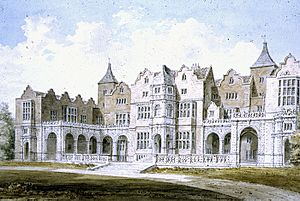John Whishaw facts for kids
John Whishaw (born 1764, died 1840) was an important English lawyer. He became a high-ranking official called a Commissioner of Audit. He was also a very influential person in a group of politicians and thinkers known as the Whigs. People even called him "the Pope of Holland House" because he was so respected and powerful in their social circle.
Contents
Who Was John Whishaw?
Early Life and Education
John Whishaw was born in 1764. His father, Hugh Whishaw, lived in Macclesfield, England. John went to Macclesfield Grammar School. Later, he studied at Trinity College, Cambridge, starting in 1783. He earned his first degree in 1788 and a master's degree in 1792.
While he was a student, John had an accident and lost a leg. This meant he could not become a priest in the Church of England, which he had planned to do. In 1789, he began studying law at Gray's Inn. By 1794, he moved to Lincoln's Inn and became a lawyer. He worked as an equity draughtsman, which means he helped prepare legal documents for fair dealings. He lived near another famous lawyer, Francis Horner, whom he met in 1802.
A Key Figure at Holland House
By 1799, John Whishaw joined a social group called the King of Clubs. This group was for important Whig politicians and thinkers. He became very close to the Fox family, who lived at Holland House. Holland House was a famous meeting place for many influential people.
People described Whishaw as "ponderous" and "inscrutable," meaning he was serious and hard to read. He was seen as an expert for the "Holland House set." Some even called him the "dictator of Holland House opinions." This is how he got his nickname, "the Pope of Holland House." One friend, Thomas Creevey, wrote in 1809 that Whishaw practically lived at Holland House. Another person, John Sterling, jokingly called him a "damned old humbug." Around 1830, Anna Letitia Le Breton described Whishaw as short and stout, with a cork leg, and a somewhat grumpy manner.
Public Service and Interests
John Whishaw became a Commissioner of Audit in 1806. This was a job where he helped check government accounts. He got this position thanks to Lord Henry Petty. When the famous thinker Jeremy Bentham had a disagreement with the government, he chose Whishaw to help settle it. Whishaw, along with John Hullock, made a decision on the matter in 1813.
Whishaw also helped manage the affairs of Sir Samuel Romilly, a well-known lawyer. He even became a guardian for Romilly's children.
John Whishaw was interested in many different subjects. He was a member of the Royal Society and the Society of Antiquaries of London. These are groups for people interested in science and history. He was also part of the Geological Society, which studies Earth's rocks and features. In 1825, he joined the first council of London University.
What Did John Whishaw Write?
Helping Explorers and Authors
John Whishaw was the secretary of the African Institution. This group worked to end the slave trade and promote education in Africa. He also became the biographer of Mungo Park, a famous Scottish explorer. Mungo Park died in 1806. In 1815, Whishaw took charge of Park's writings. He edited them to create a book called Journal of a Mission to the Interior of Africa. He even asked James Rennell, a geographer, to help with the maps and geographical details.
Whishaw did not publish many other works under his own name. It is believed he helped write Thoughts on the Restriction of Payments in Specie (1803) for Peter King. In 1815, he published a short, anonymous biography of Smithson Tennant, a chemist. Much later, in 1906, a book called The Pope of Holland House: Selections from the Correspondence of John Whishaw and His Friends 1813–1840 was published. It contained letters between Whishaw and his friends.


